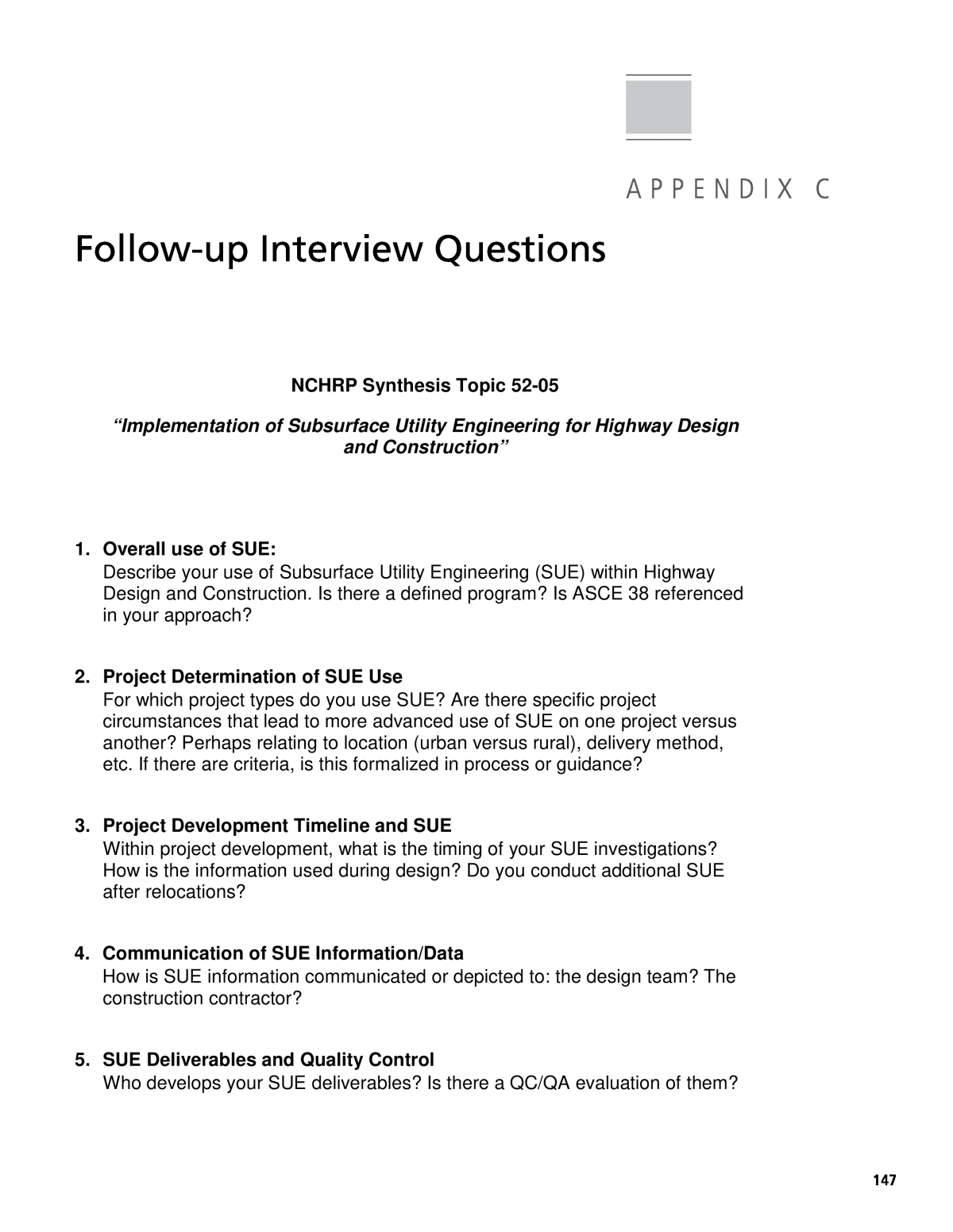



Below is the uncorrected machine-read text of this chapter, intended to provide our own search engines and external engines with highly rich, chapter-representative searchable text of each book. Because it is UNCORRECTED material, please consider the following text as a useful but insufficient proxy for the authoritative book pages.
147Â Â A P P E N D I X C Follow-up Interview Questions NCHRP Synthesis Topic 52-05 âImplementation of Subsurface Utility Engineering for Highway Design and Constructionâ 1. Overall use of SUE: Describe your use of Subsurface Utility Engineering (SUE) within Highway Design and Construction. Is there a defined program? Is ASCE 38 referenced in your approach? 2. Project Determination of SUE Use For which project types do you use SUE? Are there specific project circumstances that lead to more advanced use of SUE on one project versus another? Perhaps relating to location (urban versus rural), delivery method, etc. If there are criteria, is this formalized in process or guidance? 3. Project Development Timeline and SUE Within project development, what is the timing of your SUE investigations? How is the information used during design? Do you conduct additional SUE after relocations? 4. Communication of SUE Information/Data How is SUE information communicated or depicted to: the design team? The construction contractor? 5. SUE Deliverables and Quality Control Who develops your SUE deliverables? Is there a QC/QA evaluation of them?
148 Implementation of Subsurface Utility Engineering for Highway Design and Construction How is the information from SUE investigations stored and accessed for future use? Are these investigations made public? If SUE is contracted, who has data ownership? 8. SUE During Construction Do you conduct any SUE investigation during construction? Do your contractors ever conduct their own SUE investigations during construction? 9. SUE Program Evolution and Lessons Learned How has your SUE program evolved over time? Do you have lessons learned to share? 10. SUE Firm Successful Practices What practices of SUE firms are successful in your DOTâs view? Where could the industry do better as a whole? Do you have a prequalification process and does it appear to be working well? 11. Expanded Utility Program Are you combining, or plan to combine in some fashion, your Utility Coordination needs with your Utility Investigation needs in a more complete Utility Engineering program? 12. Proposed Locations for Relocated Utilities Do you propose alignments for utility relocations? 6. Costs and Savings of Using SUE Do you have any metrics or procedures to capture cost and time savings on your program? Do you have any documented costs or time savings or risk reduction examples on projects using SUE? What about the costs of SUE investigations? Do you have documented or perceived return on investment from the use of SUE? Have you encountered risks in conducting SUE? 7. SUE Investigation Data Storage and Access
Abbreviations and acronyms used without de nitions in TRB publications: A4A Airlines for America AAAE American Association of Airport Executives AASHO American Association of State Highway Officials AASHTO American Association of State Highway and Transportation Officials ACIâNA Airports Council InternationalâNorth America ACRP Airport Cooperative Research Program ADA Americans with Disabilities Act APTA American Public Transportation Association ASCE American Society of Civil Engineers ASME American Society of Mechanical Engineers ASTM American Society for Testing and Materials ATA American Trucking Associations CTAA Community Transportation Association of America CTBSSP Commercial Truck and Bus Safety Synthesis Program DHS Department of Homeland Security DOE Department of Energy EPA Environmental Protection Agency FAA Federal Aviation Administration FAST Fixing Americaâs Surface Transportation Act (2015) FHWA Federal Highway Administration FMCSA Federal Motor Carrier Safety Administration FRA Federal Railroad Administration FTA Federal Transit Administration GHSA Governors Highway Safety Association HMCRP Hazardous Materials Cooperative Research Program IEEE Institute of Electrical and Electronics Engineers ISTEA Intermodal Surface Transportation Efficiency Act of 1991 ITE Institute of Transportation Engineers MAP-21 Moving Ahead for Progress in the 21st Century Act (2012) NASA National Aeronautics and Space Administration NASAO National Association of State Aviation Officials NCFRP National Cooperative Freight Research Program NCHRP National Cooperative Highway Research Program NHTSA National Highway Traffic Safety Administration NTSB National Transportation Safety Board PHMSA Pipeline and Hazardous Materials Safety Administration RITA Research and Innovative Technology Administration SAE Society of Automotive Engineers SAFETEA-LU Safe, Accountable, Flexible, Efficient Transportation Equity Act: A Legacy for Users (2005) TCRP Transit Cooperative Research Program TDC Transit Development Corporation TEA-21 Transportation Equity Act for the 21st Century (1998) TRB Transportation Research Board TSA Transportation Security Administration U.S. DOT United States Department of Transportation
Transportation Research Board 500 Fifth Street, NW Washington, DC 20001 ADDRESS SERVICE REQUESTED ISBN 978-0-309-68690-7 9 7 8 0 3 0 9 6 8 6 9 0 7 9 0 0 0 0
